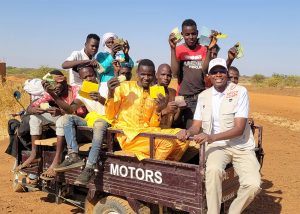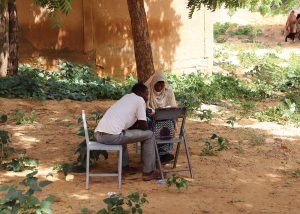
Project Status:

Background
Within international development, migration has long been considered a symptom of failed or insufficient development in the Global South. Historically, donors focused on development-in-place strategies to create jobs locally and ameliorate the factors pushing people to migrate, even in the face of climate change and conflict. Despite its potential to improve development outcomes, migration has remained misunderstood and underutilized as a policy lever by key development actors.
In 2015, as Europe struggled to manage the arrival of over one million refugees fleeing conflict, persecution, and economic hardship in the Middle East and North Africa, reducing migration became a top concern for policymakers. Addressing the root causes of irregular migration—particularly in Africa—emerged as a key component of the EU Emergency Trust Fund, and has led to subsequent policy frameworks designed to deter illegal migration to Europe. These efforts to disincentivize migration also have the potential to negatively impact regional migration.
Although migration—particularly across borders—is still widely seen as a problem rather than an opportunity, policy audiences have become more receptive to the idea of leveraging the benefits of migration in recent years.
Migration as a Livelihoods Strategy
As the hundreds of billions of dollars sent in remittances each year show, when migrants find work abroad, they don’t just benefit individually. They provide a critical source of income for their families back home and help stimulate economic development in their communities, enabling their survival during periods of scarcity and hardship.
Migration, especially seasonal migration, also has deep historical roots in many regions of the world. Taking a strict “development in place” approach ignores this reality and its critical role in sustaining livelihoods. This is the case in West Africa, where people regularly traveled in response to seasonal and climatic patterns long before Europeans drew colonial borders.
The Challenge
Underemployment in Niger
Niger is one example of a context where migration has played a significant role in people’s livelihoods for decades. Although around three quarters of Nigeriens between the ages of 15 and 64 are employed, Niger remains one of the poorest countries in the world, with half of the population earning less than the international poverty line of $2.15 per day. Given the inconsistent, temporary, and piecemeal nature of work common among those who are employed, simply having a job is not enough to ensure adequate living standards in Niger.
Climate change, decades of slow economic growth, rising inflation, and political instability are driving much of this underemployment. Most Nigeriens work in rain-fed agriculture, a sector made increasingly vulnerable by climate shocks in recent decades. Five coups since the 1970s—the most recent in July 2023—have disrupted long-term economic growth strategies. Further, regional instability has resulted in frequent cross-border incursions by outside extremist groups, severely disrupting market activity.
Together, these factors make it increasingly difficult to earn a stable livelihood in the countryside, pushing young Nigeriens to move to urban areas in neighboring countries in search of more promising job opportunities. Migration is a critical source of income nationally—in 2021, Niger received USD 542 million in remittances coming primarily from Nigeria, Benin, and Cote d’Ivoire.
Opportunities and Barriers to Productive Migration in West Africa
There is a long history of intraregional mobility in West Africa. Regular seasonal migration, pastoralism, and trade in the region predate the national borders imposed by France in the early 1900s. Since its founding in 1975, the Economic Community of West Africa (ECOWAS) has committed itself to reducing barriers to intraregional migration. Today, citizens of member states enjoy visa-free entry for up to 90 days, and many countries are making progress on the rights to reside and to work.
Despite this relative ease of movement, Nigeriens face several constraints to taking full advantage of nearby economic opportunities. Many young men interested in migrating have to abandon their plans to take care of family members or agricultural responsibilities at home. Because of limited information about a risk and the migration or employment opportunities, planning, support networks, and funds for travel or starting a small business, Nigeriens often have a difficult time integrating economically and socially in their destinations, and end up unable to support themselves or save money. This leaves them vulnerable to exploitative work and living arrangements, and possible trauma, stress, or financial hardship.
Moreover, for families left behind—particularly for wives—losing contact with migrating family members and going for extended periods of time without remittances can lead to impoverishment and a sense of abandonment. Concerns about the impact on family members can hold individuals back from pursuing more productive economic opportunities in urban areas or elsewhere in the region. While Niger withdrew from ECOWAS in 2024—raising uncertainty over whether Nigeriens will be able to benefit from visa-free travel moving forward—the question of whether and how other barriers to regional migration can be reduced remains a critical one.
The Intervention
Project Development
In 2018, IPL and Mercy Corps Niger developed an innovative model to address these challenges. The Planning for Productive Migration (PPM) project provides information, training, and resources to rural Nigeriens to promote better-informed, safer and more productive migration that will lead to improvements in economic and psychosocial well-being of migrants and their households.
To better understand the needs of young men aspiring to migrate, IPL and Mercy Corps undertook an iterative, human-centered design process. Working with local qualitative researchers, the team interviewed Nigerien migrant communities in key destinations throughout West Africa to understand migrants’ journeys, experiences in host countries, and the advice they would give to potential migrants. Gathering key pre-migration questions and post-migration advice, they compiled lessons from the Nigerian migrant community into a curriculum. The resulting insights were used to identify legal requirements for regional migration and to design a pilot program run with 100 households in 2021. IPL and Mercy Corps relied on participant feedback gathered before, during, and after the pilot to refine the implementation plan and materials for the full-scale program.
Planning for Productive Migration
In 2023, IPL and Mercy Corps launched the full PPM program. The program consists of six interventions designed to respond to the main barriers to regional migration:
- Access to information and social networks to learn how to stay safe and find work
- Trainings to help families plan for migration and establish expectations
- A smartphone for migrating members to stay in touch with their families and send remittances
- Training in soft skills for the labor market
- A $200 travel subsidy for participants who opt to migrate, equivalent to the cost of a round-trip bus ticket to one of the major economic destinations within the ECOWAS region
- Help obtaining necessary national identification and travel documentation
Through training and household counseling, the program helps participants and their families think through the potential costs and benefits of migration. If a participant chooses to migrate, the program provides resources for round-trip travel to their desired destination in the ECOWAS region. To be eligible, young men between ages 18–35 must express an interest in migration prior to enrollment in the PPM program. Whether or not they migrate is a choice each participant makes with their family after completing the training and household counseling.
The team has also set up an external advisory committee of local and regional researchers, experts, and community advocates to evaluate the project with regards to ethics, participant safety, and overall credibility. The committee receives regular reports on the project and can provide recommendations to make adjustments, pause, or terminate each stage of the program, given changes in the operational environment or the frequency of severe adverse events.
Study Design
In order to determine the effect of these interventions and whether they help participants achieve better economic outcomes than a traditional development-in-place intervention, the team is conducting a randomized control trial (RCT) with over 3,000 participants from villages of the Tahoua region. Participants have been randomly assigned to three groups:
- A group receiving the full Planning for Productive Migration (PPM) program
- A group receiving an unconditional cash transfer equivalent to the travel subsidy ($100)
- A control group in the treated villages and a pure control group where no programming takes place
This design will enable several key comparisons. By looking at the group receiving cash and the control, the study can address an unsettled debate about whether increased incomes alone encourage or deter migration. Second, by comparing the PPM and control groups, the study will evaluate the returns to facilitate cross-border migration. Finally, by comparing the PPM group to the group receiving a cash transfer, the study will determine whether PPM delivers benefits beyond those of increased income—the focus of many “development-in-place” interventions.
The program will contribute to evidence on this novel and relatively unexplored policy approach, helping governments and international organizations determine whether and how facilitating safe, legal, planned migration can be incorporated into poverty-reduction strategies for both individual migrants and their communities.
Resources
- Pre-analysis plan
- Report on PPM Pilot with Mercy Corps
- DIV Pilot project award announcement (2021)
- Webinar Zoom Recording and Resources – Migration as a Source of Resilience | ResilienceLinks , USAID , Mercy Corps | 15 Feb 2024
- Mercy Corps report: Harnessing the Development Potential of Labor Migration: Challenging the Dominant Paradigm of “Development In-Place”
- Mercy Corps position paper: Migration as Climate Adaptation
- Center for Global Development policy paper Why and How Development Agencies Facilitate Labor Migration
LOCATION
Niger, West Africa
RESEARCH QUESTION
Can providing employment information, transportation subsidies, and support to family members facilitate legal and safe labor migration, and does it improve livelihoods and wellbeing outcomes for individual migrants and their households?
TEAM
Chaibou Argi Ibrahim
Mercy Corps Niger
Alma Bezares Calderon
Mercy Corps
Darin Christensen
Immigration Policy Lab, University of California Los Angeles
Guy Grossman
Immigration Policy Lab, University of Pennsylvania
Allison Grossman
Immigration Policy Lab, Tulane University
Jon Kurtz
Mercy Corps
Ellen Reid
Mercy Corps
Jeremy Weinstein
Immigration Policy Lab, Harvard University
Jessica Wolff
Immigration Policy Lab, Stanford University
RESEARCH DESIGN
Randomized Control Trial
PARTNERS
Mercy Corps
FUNDERS
PROJECT TIMELINE
- 2018 – Scoping and partnership building
- 2019 – Program design and materials development
- 2021 – Pilot with 210 households
- 2023 – Implementation of full PPM program and randomized control trial (RCT)
- 2024 – Ongoing data collection and risk monitoring












